If you want to take the guesswork out of fishing, it’s time for you to make better use of technology and fishing information!
The 21st century has been dubbed the Information Age, and rightly so. We anglers have access to fishing websites, fishing forums and Facebook pages, plus there’s Google Earth, digital fishing logs and apps, spreadsheets for your own data, GPS and radar, plus sonar technology that scans sideways as well as down. There are now radio-controlled drones with cameras to find fish schools or even drop your baits out wide. Then there is the latest sound-based technology, such as devices to reduce noise from your electric motor, HydroWave sonic fish feeding sounds for your boat, and even lures with computer chips that emit noises, which you can program!
To some people, the sheer scale of all this information and technology can be overwhelming. They might consider it as all being too hard, conflicting or they just might not know where to start. As brilliant as technology is, you often need to know how it works to get the best out of it. You’ll also want to narrow your information gathering to focus on the species you’re targeting, the area you’re fishing and so on.
The useful information that technology provides can be your best friend – provided you know how to collect it and how to use it. This article describes in simple terms some of the latest technology to add to your arsenal, and the kind of fishing information available to you. It also outlines how organising this information and using it with the technology will help you understand why you have either been successful or unsuccessful.
There are two ways you can accumulate fishing knowledge (apart from learning on the water) and that is targeted research, or more general reading. Both have their place in making us better anglers, but one may be better than the other depending on your current fishing plans.
Whether you are researching your target species or a particular location, or just doing some general fishing reading, there is an enormous amount of fishing information available. As well as traditional media and face-to-face discussions, there’s an ever-increasing online source of information.
Hardcopies of books, magazines, DVDs and HEMA or Australian Fishing Network maps are available from traditional outlets such as newsagents, bookstores or tackle shops. These have the advantage of providing a lot of information in the one place and in easy-to-read format. Apart from monthly magazines, one of my favourite and most valuable sources of hard copy fishing information has been the publication Fish Australia: The Essential Fishing Companion. While this book was last published in 1995, it contains over 300 detailed location maps for beach, rocks, estuaries and offshore fishing for each state and territory. Check out your local library to see if it has a copy.
And don’t underestimate the human knowledge which can be passed on from joining a fishing club, building up rapport at tackle shops or simply earning the trust of a crusty old salt on the rocks, the ramp or at your local wharf. Even better, save up some money and put it towards hiring a fishing guide. Make sure though that the guide covers an area or style of fishing that you can replicate with your own gear for long-term benefit, unless of course you just want to tick a glamorous fish off your bucket list.
Online fishing information has grown exponentially, and has the advantage of being easy to search – and often it’s very up to date as well. It’s not just available on regular websites – you can also access it via apps on smartphones and tablets, and through social media like Facebook. You can easily create your own digital fishing information as well, by putting diary entries in an electronic fishing log or spreadsheet (an invaluable research tool). Each of these sources of information are described below.
The choices here are incredible. There are apps on the weather, fishing diary and sounder apps (mentioned later in the article), apps for tying knots, navigation and finding boat ramps, and even fishing games like catching a marlin! Games aside, these are great supplementary sources of information. Personally though, I believe the weather apps are the best of the lot. I love Seabreeze and Weatherzone for up-to-date wind and weather information. In terms of the commercial apps, The Australian Fishing App (currently $2.99) is a very popular android app containing a lot of fishing tips and rules, and it’s interactive in that anglers can share their reports with fellow users. The Catchability app is another good (free) app for both iPhone and Android devices.
When it comes to useful websites, there’s a huge range available. Many tackle companies have tips and tricks on their sites, plus there are helpful fishing forums and blogs (online journals) from both well-known anglers and amateurs alike. Just do a Google search for ‘fishing forum’ or ‘fishing blog’, along with the region or species you’re interested in, and you’re set.
Fishing blogs and forums differ from traditional websites in that they’re interactive, allowing anglers to post comments, photos and/or questions. In many cases you’ll see feedback that’s interesting and useful, but you’ll also get naysayers who think your pics have been Photoshopped, or who are just downright rude. Fortunately these ‘keyboard warriors’ are in the minority. Often it’s best to just ignore them (which they don’t like one bit). Life is too short!
A Facebook page is like a cross between a blog and a mini-forum. The administrators share information and reports, but you can usually ‘Like’, post comments and upload your own pictures and reports. Don’t tell yourself you’re too old for Facebook! It’s too useful to pass up. It takes only a couple of minutes to create the simplest of profiles so you can get full access to Facebook fishing pages. Many have great giveaways, up-to-date reports, tips, pictures and videos you may not see anywhere else. Many Facebook fishing pages also have funny pics and jokes too!
Facebook is definitely my preferred mechanism for sharing information with other anglers, and I have a great bunch of followers (people who clicked ‘Like’) on my page which makes it like a great big fishing family that I keep in regular touch with.
Many of us have our favourite locations to fish season after season. However, we don’t have perfect memories, and over time we start to wonder which fish were caught when, how, where and by whom. And it’s easy for some exaggeration to creep in there! The solution is a fishing diary. It gives you the black and white truth! If you haven't got one, start a fishing diary on your next trip – and make sure it’s electronic. That way you can easily search, sort and compare the diary entries to identify patterns in fish movement and behaviour. Handwritten notes can’t do that.
One way to create a fishing diary is with an app for your smartphone or tablet. Unfortunately, many of the apps available have been designed for fishing in the northern hemisphere. The few Australian fishing diary apps I've come across include the Total Fishing Australia App (lite and full version), but only the full version has the diary option. It costs $5.99 to download. It has mixed reviews, so you’ll probably want to try the lite version before you fork out for the full version.
Another app is Fishabout, which is free with mixed reviews. I downloaded it to test the fishing diary option, and while it has some basic variables for you to record, including an option to view others’ reports and share your own, unfortunately some of the detail you require is lacking. For example, the location options aren’t very specific (e.g. ‘Brisbane area’).
A second option, and one which I used for a number of years, is to create your own diary in an Excel spreadsheet so you can repackage it easily into tables and graphs. Include information on the location, date, moon, tide, time, wind, water colour, bait or lures and other conditions along with the species caught (and their quality) by each angler. Create a legend which simplifies the amount of data you have to enter each time. For example, when it comes to the size of the fish you can put A = large, B = around legal size, C = mostly undersize.
Using a fairly simple function called ‘create pivot table’ (hop on YouTube to learn how to use it), you can highlight an area in the spreadsheet and then use a tick box to select which of the column and row variables you want to see in a table. Once you have this you can then put it in a graph (which is the best way to compare fishing variables over time). Doing this allows you to take a particular location, fish species or angler to identify patterns over time such as quality of fish by moon phase, tide, bait or lure type and time of year.
The third option is to use specialised software in the form of a fishing log, which I believe is the best option for a fishing diary. Ken Fox’s Fishing Log has been around for a number of years and has been designed especially for Australian conditions. Fishing Log makes record keeping a very simple ‘point and click’ exercise with just a few variables needing to be keyed in. You could even record your previous hand-written fishing diary in a matter of a few hours and be able to use the software to analyse your past catch. Here’s a quick look at a few of the features.
The Log Book: this is where you can enter all relevant data under predefined headings such as date, area fished, ramp launched at, number of crew, hours fished, time departed, sky, wind strength and direction, barometric pressure as well as sea conditions. You can also view or search for past records, which might help you decide where to fish for your particular target species on the basis of the tide/moon and wind forecast.
Tide times: As well as reporting times and heights of changes it draws daily graphs, calculates percentage flow rates, graphically displays moon phasing, sun and moon rise and set, shows the whole tide cycle, adjusts to secondary locations and more.
Fishing spots and GPS waypoints: Maps of all of Australia are provided, including more detailed maps of local areas. You can record and point and click on locations to see previous catches, plus more.
There are automatic updates in the first 12 months and future updates for a nominal fee. The Log also includes fish facts and step-by-step pictures of many knots and videos.
The Fishing Log is available direct from Ken Fox on 08 8298 4527 or --e-mail address hidden-- for $99. Whilst it comes in an older style CD-ROM, make no mistake – it’s a great software package.
Now that you know how to gather more fishing knowledge, you might like to consider what new fishing technologies would suit your angling targets and techniques. I’ve separated these into boat and land based technologies, although some apply to both.
The greatest leap in sounder technology in the past decade has been the introduction of side or structure scan. This feature really makes a big difference to your fishing in salt or fresh water. Combined with downscan technology, it delivers picture-like views beneath the boat, including the ability to scan sideways approximately 75m to the left and right of the boat. It allows you to determine the depth of the fish and bait, and when you use it in conjunction with features such as Lowrance’s TrackBack, you can scroll back in the recorded history to review structure or fish targets and pinpoint locations with a waypoint for further exploration.
Lure manufacturers are constantly looking for an ‘edge’ in the saturated lure market. Technology that is so new it is still to be released in 2015 is Livingstone Lures’ electronic baitfish sounds (EBS) that will have four programmable sound modes. The EBS technology is embedded in a smart chip in the sound chamber of each lure, which is activated when the lure is submerged. The sounds mimic natural baitfish noise, with anglers able to choose from the sounds simply by pressing contact points on the lure. These are expected to prove very popular for bass and walleye fishing in the US, and will no doubt prove effective on Australian species as well.
There’s also a variety of lures on the market with LED lights that automatically activate when the lure is submerged. These have had good results on a variety of Australian fish species and squid at night.
Most anglers know that you can talk as loud as you like on the boat, but banging the bottom of the boat is a no-no due to the unnatural vibrations it emits under the water. Competition anglers are particularly focussed on minimising noise, and this includes looking for ways to reduce or cover the noise from their electric motors (despite the fact that electrics are quieter than ever).
There is now a device that can do both and potentially more, with claims that the HydroWave Fish Feeding Simulator also attracts fish to the boat. It emits the natural sounds of baitfish and predatory fish feeding on them. You can adjust the volume and type of sounds by using a hand-held or mountable device that activates the underwater speakers. By hearing the sounds and feeling the vibrations, the fish are said to be drawn in the direction of the HydroWave. At the very least, pro bass anglers in the US say it disguises the unnatural noise from the boat, and the fact that 100% of bass pro boats use it makes this claim pretty hard to argue with.
There is also a mini HydroWave version suitable for kayak fishing (or even from the bank), retailing for about $139. The larger HydroWave Australian H2 system package, with more bells and whistles, retails for around $650. They are available in fresh and saltwater versions.
Anglers looking for an advantage in tournaments, or just those who are keen to catch more fish, are increasingly using devices which reduce the vibration and noise from their electric motors. There are a couple of fairly simple and inexpensive devices on the market that do this.
Propeller Dynamics are one such retailer of these devices. Their Eliminator custom prop nut has a Durometer O-ring that helps to remove prop noise/vibration while its cooling points help in heat dissipation. Propeller Dynamics also sells The Silencer, which for only a few dollars greatly dampens mount noise by preventing some parts of the mount from touching each other.
Spot-lock on electric motors takes out the need to use your anchor when throwing plastics or other lures around a school of feeding fish. This technology is also handy for throwing unweighted or lightly weighted bait at snags or undercut banks, then moving on with much less noise and fuss than dropping and lifting your anchor. Used in combination with trolling motor silencers or fish feeding noise simulators, you’re giving yourself the maximum chance of success!
Radars are also an excellent safety device on boats, but few anglers realise they can also be used to your advantage to find fish! RayMarine have a high-definition digital radome (bird radar) which can be set to automatically detect birds ‘working’ a bait ball, well beyond the range of what we can see with the naked eye.
You might think that technology wouldn’t help much when fishing from a beach, the flats or your local jetty. Not so! Here are some pieces of technology to help you get more consistent results from the shore.
The most obvious bit of technology to use when researching fishing spots is Google Earth. This could be as simple as finding some dirt tracks off the main road to less-fished beaches or waterways. However, Google Earth also opens up many more opportunities. It’s one of the best ways to get a picture of the area you plan to fish, for example identifying locations where you can fish the drains for flathead.
As an example, before a recent trip to the western side of Moreton Island I made quick scan of the location on Google Earth. This let me pinpoint areas with a number of small creeks draining into the bay. This is perfect for flathead fishing, especially on the falling tide, and that is how it turned out on this particular day. The fish were lying in ambush near the entrance of these small creeks waiting for the baitfish and prawns to flee to the deeper water as the tide dropped. You can see the spot marked with an X on the Google Earth map on this page.
A portable GPS is a great tool for the shore-based angler. For example, when 4WDing on Queensland’s Fraser and Moreton islands we have used a portable GPS to mark gutters at low tide to come back and fish later. This takes the hassle out of relying on your odometer reading, which you can either forget to check when you exit the beach or you simply can't recall what distance it was when you go to fish a few hours later!
Portable GPS units can also be used for fishing the flats. You can use this device to mark locations as you walk out over the flats at low tide and notice larger melon holes/channels that are dry but will fill on the rising tide. Likewise, you can keep an eye out for where a few flathead have buried themselves in the sand during the last high tide and waypoint these. This takes the guesswork out of finding these spots as the tide rises, particularly when the flats are expansive.
Anglers fishing from the shore (or in a kayak, canoe or float tube) in an estuary, river or lake often don’t know much about the structure and depth of the water in front of them. Even zooming in on the area with Google Earth will only show up shallower sand bars. A castable sounder, however, has the potential to show you underwater structure like undercut banks, submerged trees, logs, boulders or the edges of weed banks. These are the sorts of areas that can hold congregations of fish such as bream, yellowbelly or trout.
In the last couple of years the choice and functionality of these units has improved substantially. Humminbird have been making a well-known castable unit for a few years now — the SmartCast, which sends signals to a wrist or rod mount display. You simply attach the sensor to your line for a real-time view of fish, bottom and underwater structure right where your line is. Or you can use the Remote Sonar Sensor to preview an area before you fish, by casting it out and reeling it in for an accurate picture of what's below.
In recent years the portable sonar market has expanded and you can now choose from products like Deeper, FishHunter, iBobber and SonarPhone’s T-Pod, which range in price from $100 to $230. These units pair up with iPhones or Android devices using Bluetooth or Wi-Fi, and have additional functionality such as fishing logs, solunar information and water temperature. Some also work with marine or Navionics charts.
A more controversial piece of technology, and one whose popularity is set to grow, is the drone. The most impressive consumer drone in recent times has been developed in the Netherlands and is known as the Dronexpert Quick-release. With this device the angler attaches their bait and line to the drone and then uses a remote to fly the drone out over the water. The angler then lands the drone on the water, where it is able to remain buoyant. A camera system with the bait is then lowered to the bottom on a winch, allowing the angler to check whether the area is obscured on a display. Once the device reaches the bottom, the bait is released. The drone then returns to the angler, ready to be used again. No price on this device has been announced, but I suspect it won’t be cheap!
As cool as they are, all the latest fishing gadgets in the world aren’t much good without the general fishing knowledge to back it up. In my view, information gathered from fishing magazines, websites, videos and the like will give you the solid foundation you need to catch more in the long run – and you can draw on this know-how down the track when you buy your new technology. It isn't much use having the best radar, sidescan and electric motor technology if you don’t know what you’re looking for, or how to interpret it. You don’t want to be out on the water, staring at a screen and wondering what to do next!
Here is a sample timeline for putting it all together.
Step 1: Assuming you have already amassed a reasonable amount of general fishing knowledge, turn your attention to finding out as much as possible about your preferred species. This can include factors like the best time of year to target them, what influence different sea conditions will have on (say) beach fishing, and what alternative targets to focus on in certain conditions.
Step 2: Wet a line and look at your environment while you wait for a bite. What is the wind doing? Is it overcast? What is the water colour? What did the fish you caught have inside its stomach? Record all this in your electronic fishing diary or log (including dud days – we all have them!) After a while you’ll be able to search or graph your results and see patterns emerge.
Step 3: Now you are armed with that information, focus on your next trip. Lock in a few variables such as the time of year, tides, target species and the location. If you are going on a family holiday to a new destination, jump on the web and look up information on the area, or jump on a forum or local Facebook page (including the local tackle shop or even just keen local amateurs) and ask questions. Look at your weather app to help with planning, particularly close to a week to 10 days out.
Step 4: Let's assume you have decided to buy some new technology. Pester your local tackle shop or marine dealer to demonstrate or describe how it works first. If they are not prepared to do that, take your business elsewhere. Then read the manual! You can’t be an expert right away, so be prepared to do a bit of trial and error with your new device by having a test run with it before your trip. There are even gurus like Nick Whyte in Brisbane who will guide you through getting the best use of sounders etc. by providing on-water lessons. This will fast-track your learning.
Step 5. Catch more!
Above all, remember that on some days the fish can be shut down and there’s nothing that can be done about it. But whether the fishing is good or bad, you’ll at least have the confidence that you’re using all the right tools – and those tools and knowledge will help you understand why it was a good or bad day’s fishing. In particular, it will help you remove some of the guesswork so you’ll be even better armed on the next trip!
For more tips and fishing advice, check out my Facebook fishing page, Ontour Fishing Australia. Until next time, bag your mates – not your limit!
Ken Fox's Fishing Log is a must-have for anglers keen to study past patterns in their catches.
Reads: 14400
Google Earth is a great tool to help you search for fishy features like drains for flathead.

Put all the pieces together and you can catch fish like this!
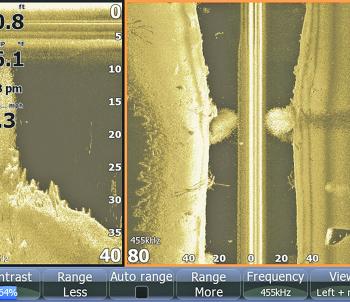
Side or structure scan technology delivers you picture-like images of the bottom.

Raymarine's radars can pick up birds working beyond where you can see.
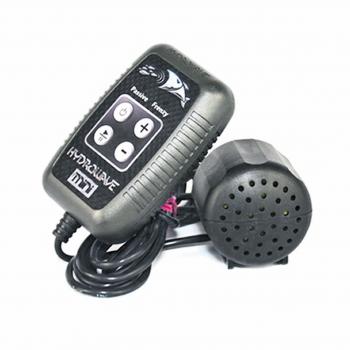
The HydroWave fish feeding simulator is very popular with bass pros in the US.
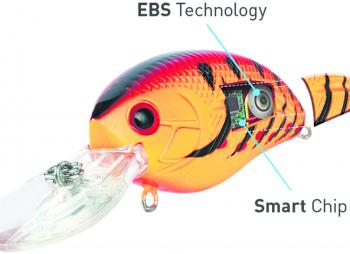
Lures with computer chips and sounds may be the way of the future.

and 7

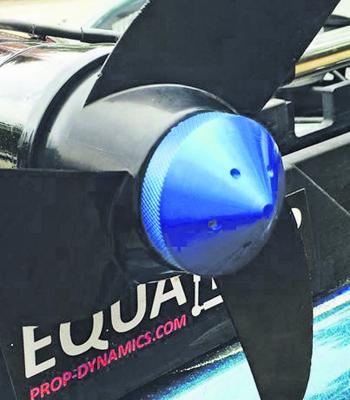
Electric motors can be quieter than ever with the addition of special prop nuts and silencers.
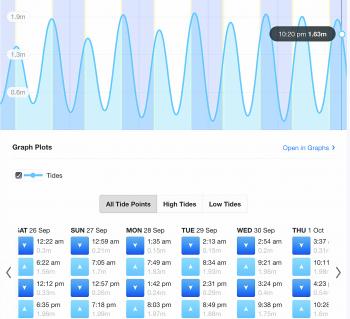
Apps and websites give you all the weather information you need to know for your next trip.




